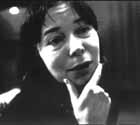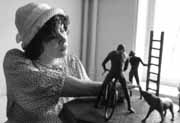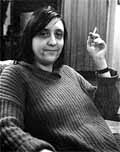A woman can create…Anna Alchuk
Tatiana Antoshina, an artist:
But the tone of the TV discussion and conclusions, made during it, don't allow to satisfy myself with a terse rejoinder and demand a detailed answer. The reason for conclusion of spiritual and physical inferiority of a woman is prevalence of men contribution to "the treasury of world art". As everybody knows, arts are conventionally divided into spatial and temporal; and a word "masterpiece" is obvious to be applied to all the types. Reproach (or warning that you shouldn't poke your nose into other people's affairs), cast by the presenters of the program "Cultural Revolution", concerned women occupied in spatial art (fine arts, architecture). But the question of women contribution couldn't be considered beyond cultural context. It is not a secret, that over centuries patriarchal social principles didn't allow a woman to go in for arts. She could only be a object of creativity but not its "creator". It is difficult to imagine a woman who was charged with a construction of a medieval cathedral. In spite of this fact, the end of the second millenium is noted for a growth of women consciousness and a protest against a role, assigned to a woman in the society, and especially in art. In comparison with milleniums of patriarchy this period of time is so short that it is difficult to talk about women contribution to traditional art. At the same time, only in Russia in the XXth century we can mention such poetesses as Anna Ahmatova and Marina Tsvetaeva, sculptors Muhina and Golubkina, fine arts of Serebriakova, artists, called Amazons of Russian vanguard: Ester, Popova, Udaltsova, Goncharova and others. Those, who are now working among us, in future will be put down in the book of art history. As for the theory of peculiarities of thinking, initiated in the right and left cerebral hemispheres, as far as I know, both cerebral hemispheres are interrelated; lack of one or another would make a person an invalid. I want to believe that A.Gordon didn't mean that women lacked logical thinking. Otherwise, I had to suppose that he equated a woman with an animal, and the whole world of East "with its sobbing, conjuration, birth pangs and the like" together with her. So far as I know, this theory speaks only about peculiarities of functions in the right and left cerebral hemispheres. The fact, that women more often use right cerebral hemisphere, and men - their left one, needs to be proved. Even if we suppose that this suggestion is right, it does not mean that women are unable to create, for right hemisphere thinking, arrogated to women, is just figurative. Entire, vivid thinking is built of associative images; it is paradoxical, figurative, it more clearly reflects the world and is creative; it is more suitable for art and theoretical sciences. Modern world aspires to integrity. Information, accumulated in different sciences, needs systematizing and comprehending in a new fashion. If a woman really possesses right cerebral hemisphere thinking, she is privileged, and not only in art. We could ignore unpardonable attacks of A.Gordon on the whole feminine gender; unfortunately, obstinately concentrating on physiology, he expresses or "conceptualize" the opinions of a certain audience. The reaction of many women in the lecture-room during the discussion depresses - the pathos of some speeches came to a tender babble: "Men, what would you do without us? We inspire you to create masterpieces". Such words are the results of platitude, pouring on us through the TV-screens. Television is also art. It is difficult to say that Russian TV belongs to art, and that its programs similar to the above mentioned talk-show can be called "masterpieces". It is rather an unsuccessful example of merging of new technologies with spiritual backwardness and male chauvinism. Nina Gabrielian, authoress and critic:
If we talk about so-called "author's" art, we can say that the names of famous men are really more well-known than women ones. But fame is a social phenomena and there is no direct relation between talent and fame. Beside the works of art, which authors' names are familiar to us, there is a great sphere of nameless art (amateur arts). There are enough reasons to think that as much as a half of it was created by women: lullabies, wedding songs and others. And it is in amateur arts where all those methods - prosody, meloth, rhythmic rhyme structures, etc., which became the basis of author's art, were worked out. That part of history of art, which is most often referred to, covers only a small period of human existence, and mainly, the period when men socially prevailed (patriarchy). But discoveries of modern archaeology shook our assurance that it was always so, and rendered us relics of female centrist cultures. That is why it would be more correctly to avoid a question about the rate of men and women talents, but to ascertain who in the patriarchal period, rather due to social reasons than to "natural" ones, had an opportunity to realize themselves in art and in what arts. And why those arts, where men dominated for some period of time, are still considered of more prestige by educated people ("masterpieceful"). Since for the last several milleniums our culture is of an androgenous nature (a man is in the center of the culture) we still take into account the author's sex when estimating a work of art. Thus, for example, description of wars, which subjects are men, is estimated as adverting to global problems, common to all mankind. While description of pregnancy, delivery, breast feeding is considered secondary, "private", "women" subject, - not common to all mankind. It is an evidence of a clear civilization fault, i.e. when descriptions of destroying human life is considered "global" and "common to all mankind", and drawing our attention to emerging of life is estimated as private, secondary. But while only women give birth (who, by the way, amount to 53% of the Earth population), all of us are born: both women and men - so all of us have a birth experience. It's astonishing, that a number of cultural workers are so unaware of the processes, taking place in the world art, that unreflexively produce stamps "of times of Ochakov and Crimea conquest" and remain completely ignorant of the fact that nowadays many talented women work in the world art, as well as in Russian art in particular, who long ago became world-famous. Natalia Kamenetskaya, artist and curator: Are women able to create masterpieces? Recently this tactless statement, both form scientific (there are no clear definitions here) and common point of view, was made in a popular TV program, and with great pleasure I would have ignored it like the previous day anachronism, if this question hadn't been put before a great number of inexperienced TV viewers. Again emerging discussion about women ability to any creation except child-bearing, is for sure another wave of reaction at exhibitions "Amazons of women vanguard" and "Art of female gender", which recently took place in Moscow (the State Tretiyakov Gallery). The last exhibition, which was visited by several thousands of people, who had to stand in long queues, especially offended and caused a storm of contradictory emotions. It is interesting that Moscow critics, engaged in "male" art-market, surpassed themselves trying to prove that there are no masterpieces in female art. Though at the both above mentioned exhibitions some outstanding works of art were certainly represented - whether competitors or jut stinging men wish to confess it or not. If you haven't yet discovered masterpieces of women authors, flicking through the history of arts, I recommend you to turn to the history of the question. For example, read the article of Linda Nohlin "Why are there no great female artists?", where the author easily explains that "the question is not in the stars, in hormones, in menstruation and not in internal sledge rugs of the organism - the question is in institutions and in education…" I won't again analyze evident now social cultural reasons, due to which the history of arts, at least till the XXth century, mostly recorded men names. Even now conditions for engaging oneself in art are known to be unequal for men and women. Nobody here denies talent as a "natural" (or a given "from above") quality of an individual, but there is still no degree of talent beyond social context. In modern society a woman, in spite of all the obstacles, quickly "score up points". More and more women works of art become generally recognized, are acquired by museums, bought from the bookshelves of book-shops. I have already mentioned that now "women" exhibitions rouse the public interest more than exhibitions "in common". Another circumstance of no small importance. In modern world a label "masterpiece" is not defined by taste, but by the market. Today invested capital, cost of a work of art bought at the auction (everybody knows what a complicated intrigue, economical laws and offstage games are behind price politics!) provide immortality for the authors name and his work. For some actual for patriarchal society, but short-lived reasons, capitalists still don't put up money in women works of art. That is why we still don't know the "masterpieces".
Elena Elaguina, artist: A word "masterpiece" today has become out of date, or, if you want, it has a meaning given to it by TV advertisements, for example: "A masterpiece of digital technology - TV set LG". Refrigerators and squeezers, vacuum cleaners and cars may be declared similar masterpieces. I.e. the matter concerns goods which are products of collective work, and women take the same part as men.
Marina Obukhova, artist and designer:
By chance switching on the TV set I found myself involved in the discussion: are women able to create masterpieces? The first reaction was: it must be a new comic program! But instead of Petrosian the other clown asks funny questions. Usually boring Gordon was unusually lively and aggressive stating: "No. They are not able". Usually forceful and energetic Masha Arbatova took motherly indulgent and calm stand: "They are able. Women can do anything". The atmosphere and absurdity of the subject reminded us a village club of Soviet times, when the questions: "Is there life in the Moon?", "Is friendship between a woman and a man possible?", were very popular; the difference was only in the fact that most of the participators came by foreign cars instead of carriages. Unreasonableness of the raised question astonishes. Why not make the next theme of the program: "Are the Jews able to perform opera arias?" or "Can Negroes be considered human beings?" Russian men seem to feel more and more diffident beside a woman who more and more often has to build a house, and to bring up a child, and to plant a tree by herself. I know many talented women and many ungifted men (who even made a name for themselves). More and more women are engaged in business, in politics, in art. A man has to surrender and offended by this circumstance he tries to prove himself in the right, repeating conjuration: "No! A woman cannot! She is not able!" And a wise woman says: "Of course, darling, of course", - and keeps building a house, bringing up children and planting a tree, creating masterpieces without looking aside on dull arguments. Oksana Sarkician, Artist and critic:
This historical information demonstrates the development of discussion about genius. For today, it seems to me, there are no doubts that women views, women identity and women art greatly change stereotypes, formed in patriarchal society. Active participation of a "female gender" in social processes changes the whole system. I think that using the word "genius", even taking into account already existing reservations concerning this concept, we should agree that the position of feminism itself is ingenious. It suggests a new view, it carries a conception of now world order and, without any doubt, it reflects a concrete historic period on the whole. Today it is already not popular to talk about individual genius. The latest mega-stars, having similar reputation, lived 40-50 years ago. Today the society is more interested in local demonstrations, one of which is genius. During social progress the word "genius" may acquire a new meaning and comprehension. I don't think that within common social reality both for women and for men we should separate women and men genius. It would be more reasonable to try to find its new non-gender meaning. As we can see, for all creative women both the theme of the program and its discussion with the help of the given terms seem inadequate. But even if we get down to discussing this problem, using such definitions as "masterpiece" and "genius", formed in patriarchal period of history, we will easily name lots of women, which became a part of world history, starting with Sapho and ending with Camilla Clodelle or Marina Tsvetaeva. An amazing situation took shape in Japanese literature of Heiansky epoch (IX-XII). A famous translator Vera Markova writes in her foreword to a collection of ancient Japanese stories that "a curious fact, that Heiansky literature is women work, can be explained by neglect of men form aristocratic society to their native language. A number of wonderful authoresses and poetesses appeared: Ono-no Komaty, Say-Sanagon, Murasaky Sikibu, Idzumy Sikibu and others". Thus, Murasaky Sikibu at the beginning of the XIth century wrote the first world big roman "Gandzy-monogatary", based on the evens of real life. It proves that as soon as in some arts in a certain period of time there were favourable conditions for women self-expression, talented representatives of female gender always turned out, managed to use it and for a small period of time compensate the centuries of women silent presence in art. For example, in the XXth century, when women were able to get artistic education, many outstanding female artists appeared. In Russia there were Natalia Goncharova, Alexandra Ester, Lubov Popova; in America - Georgia O'Kiph, Sindy Sherman, Barbara Kruger; in France - Tamara de Lempica; in Germany - Rebecca Horn and many, many others. I don't make it my aim to name all the outstanding women, otherwise I would require several pages only for them. Even taking into account the stamps of mass perception, for which such concepts as "masterpiece" and "genius" are still significant, we would easily show that there were lots of women in our history who deserved these definitions.
|
 Michail Shvidkoy's program "Cultural Revolution", where a provocative statement "Only a man can create a masterpiece" was discussed, caused fair indignation of not only women but also men and revealed a number of problems, connected both with state of modern Russian society and with the way of representation of women in history.
Michail Shvidkoy's program "Cultural Revolution", where a provocative statement "Only a man can create a masterpiece" was discussed, caused fair indignation of not only women but also men and revealed a number of problems, connected both with state of modern Russian society and with the way of representation of women in history. A dictionary of foreign words gives the following definition of a masterpiece: 1. Exemplary article (in medieval guilds) for becoming a master; 2. A work which is the highest achievement of art, of workmanship. The question, proposed for discussion, probably touched the second, the most exalted meaning of the word. However, we must mention, that at the end of XX - at the beginning of XXI centuries both criteria of estimation changed and concepts of art and non-art were washed away. Such categories as "the sublime" and "the beautiful" almost don't work in modern art. That is why such concept as "masterpiece", connected with them, decreased in value, is not actual now and is more applicable to the art of the past.
A dictionary of foreign words gives the following definition of a masterpiece: 1. Exemplary article (in medieval guilds) for becoming a master; 2. A work which is the highest achievement of art, of workmanship. The question, proposed for discussion, probably touched the second, the most exalted meaning of the word. However, we must mention, that at the end of XX - at the beginning of XXI centuries both criteria of estimation changed and concepts of art and non-art were washed away. Such categories as "the sublime" and "the beautiful" almost don't work in modern art. That is why such concept as "masterpiece", connected with them, decreased in value, is not actual now and is more applicable to the art of the past.
 The conception "masterpiece" is rather relative. In different epochs different types and genres of art were considered more or less significant by the contemporaries. There are no "natural" reasons to think that, for example, monumental sculpture (a branch of art where due to social reasons men had an opportunity to show their worth) - is a more valuable form of art than embroidery, where women were mainly occupied.
The conception "masterpiece" is rather relative. In different epochs different types and genres of art were considered more or less significant by the contemporaries. There are no "natural" reasons to think that, for example, monumental sculpture (a branch of art where due to social reasons men had an opportunity to show their worth) - is a more valuable form of art than embroidery, where women were mainly occupied.

 A surprising reaction on the exhibition "Art of female gender". Whether it is a coincidence or not, but the theme "A Woman in Art" suddenly became very popular.
A surprising reaction on the exhibition "Art of female gender". Whether it is a coincidence or not, but the theme "A Woman in Art" suddenly became very popular.
 As for such conception as "genius" Sidny Nemser in 1975 declared that women are not endowed with it. Carol Duncun in her review of her book stated that we couldn't accept genius and greatness as universal, temporal and indisputable conceptions any more. It was Norma Broudy who played a vital part in forming new interpretations of definitions themselves, i.e. the most discursive matrix of art research; she expressed an idea that the discussion about genius only demonstrated the influence of patriarchal judgement of art, according to which works created by women may never be estimated as something valuable.
As for such conception as "genius" Sidny Nemser in 1975 declared that women are not endowed with it. Carol Duncun in her review of her book stated that we couldn't accept genius and greatness as universal, temporal and indisputable conceptions any more. It was Norma Broudy who played a vital part in forming new interpretations of definitions themselves, i.e. the most discursive matrix of art research; she expressed an idea that the discussion about genius only demonstrated the influence of patriarchal judgement of art, according to which works created by women may never be estimated as something valuable.